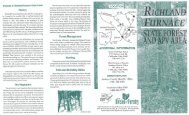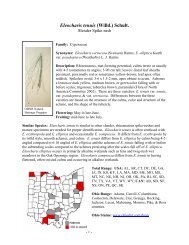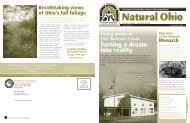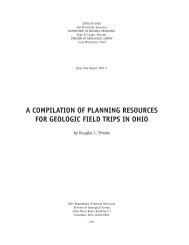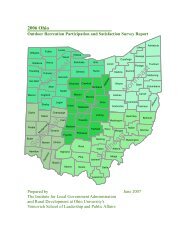Owls of Ohio - Ohio Department of Natural Resources
Owls of Ohio - Ohio Department of Natural Resources
Owls of Ohio - Ohio Department of Natural Resources
Create successful ePaper yourself
Turn your PDF publications into a flip-book with our unique Google optimized e-Paper software.
are winter visitors. Like the long-eared owl, our impression <strong>of</strong> their status is skewed bythe difficulty <strong>of</strong> finding these secretive birds. In recent years, a research effort known asProject Owlnet, which is a consortium <strong>of</strong> bird banders in North America and Canadathat focuses on Northern saw-whet owls, has shed considerable light on populations <strong>of</strong> thisowl and their seasonal movements.In <strong>Ohio</strong>, a group <strong>of</strong> banders affiliated with Owlnet began saw-whet studies nearChillicothe in Ross County in 2003. In the fall <strong>of</strong> 2004, they caught an amazing 45 owlsat one location within a two-month period. To date, in four seasons <strong>of</strong> banding they havecaptured nearly 120 different owls. <strong>Owls</strong> caught in Chillicothe have been recaptured inIndiana, Minnesota, and West Virginia. <strong>Owls</strong> previously banded in Maryland, Ontario,Canada, and Michigan have been caught in Chillicothe. The frequency <strong>of</strong> captures in <strong>Ohio</strong><strong>of</strong>fers a glimpse into the potential numbers <strong>of</strong> owls that may migrate through <strong>Ohio</strong>.Most saw-whet owls pass through <strong>Ohio</strong> on their way to wintering grounds in states to oursouth. Some individuals do overwinter, though; several are found each winter.Documented nesting records are very scarce. There were summer records from about 16counties prior to 1940; all were in the northern half <strong>of</strong> the state. In recent years, there havebeen but a few reports <strong>of</strong> potential nesters, mostly in the Cleveland area. Based on historicalreports, it seems likely that only Ashtabula County may have once had an establishedbreeding population, but this population is probably no longer present. However, this owl iseasily overlooked and it’s possible that they still sporadically breed in <strong>Ohio</strong>.Saw-whets are very rare <strong>Ohio</strong>breeders. Juveniles arechocolate brown.Photo by: ©Alan Brady / VIREOHab itat s aw -w h e t o w lThe saw-whet is a forest owl, although tolerant <strong>of</strong> a wide variety <strong>of</strong> woodlands. Peakbreeding populations occur in coniferous forests, but saw-whets will nest in a range <strong>of</strong> foresttypes, and age classes. Migrant and wintering birds turn up in shrubby thickets, youngsuccessional woods, grapevine tangles, planted conifer groves, and scattered ornamentalconifers in cemeteries. Probably hunts mostly in open woods or along woodland bordersor openings.Hab its saw -w h e t o w lNorthern saw-whet owls are strictly nocturnal and very difficult to locate duringthe day, as roosting owls blend well with their surroundings. <strong>Owls</strong> holed up in thickgrapevine tangles are especially difficult to spot. However, they tend to perch fairly lowto the ground – anywhere from five to fifteen feet – which makes spotting one a bit moreAdult saw-whet captured bybanders near Chillicothe, <strong>Ohio</strong>.Photo by: Bill Bosstic



